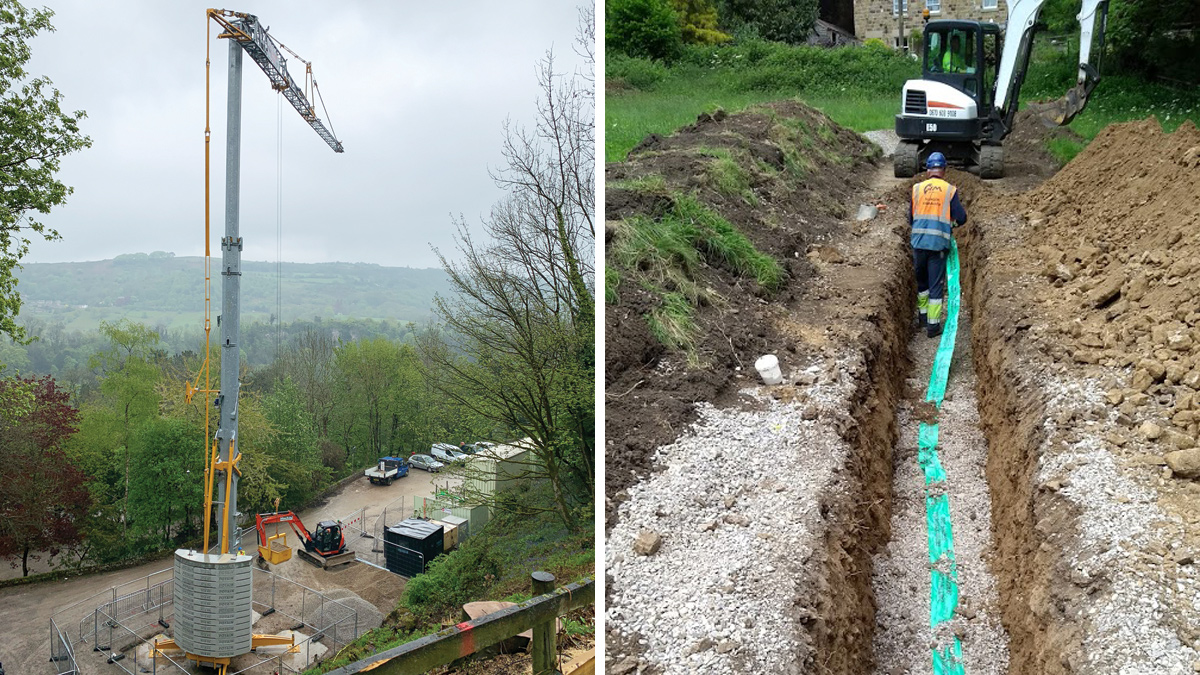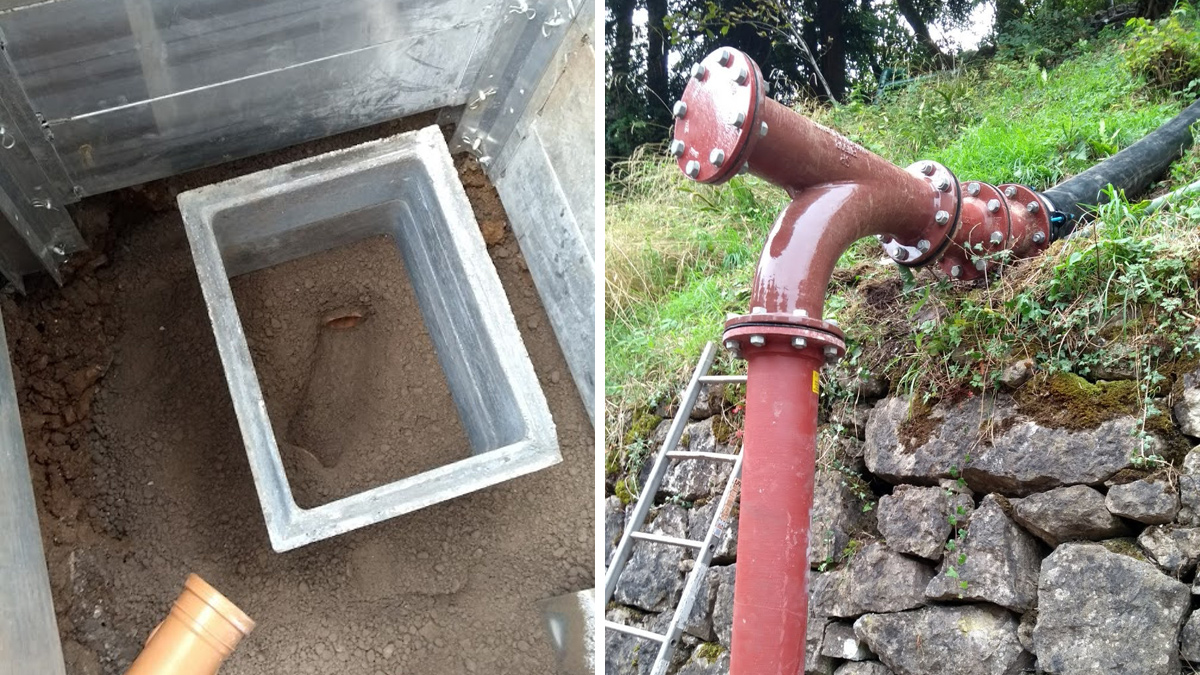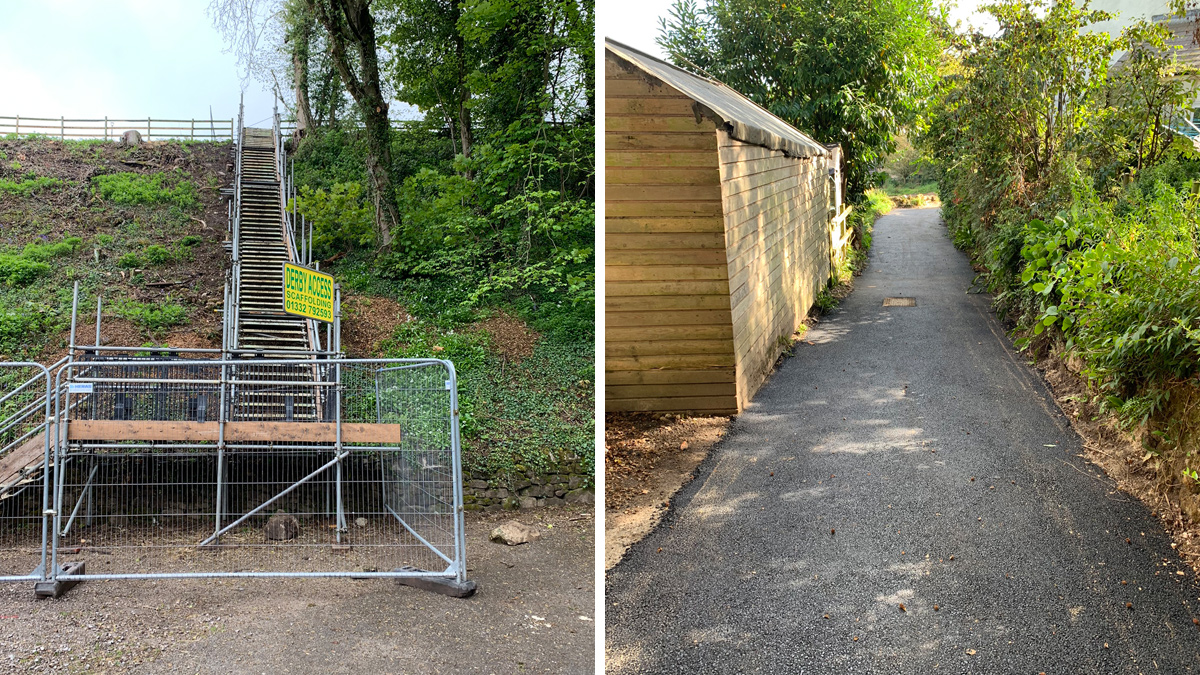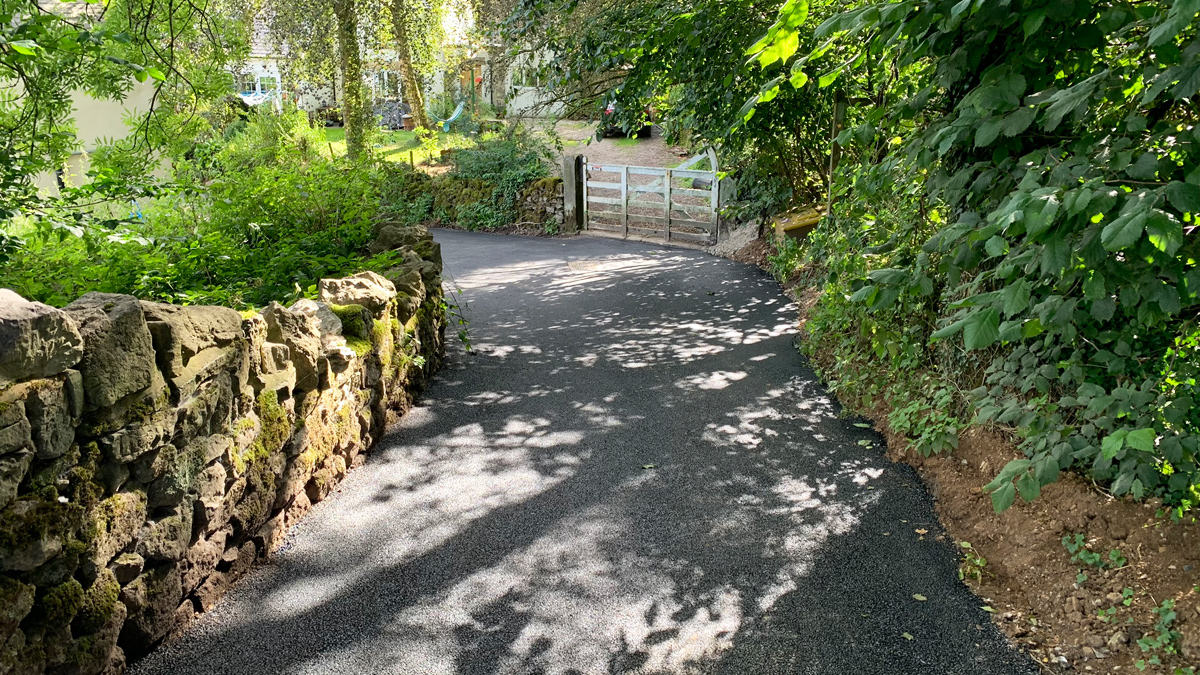Upperwood S101a – First Time Sewerage Scheme (2020)

(left) Ladybird crane erected to transport all materials into Upperwood Village from Gulliver’s Kingdom and (right) pipelaying through the paddock adjacent to Upperwood Village. Weathered limestone outcrops made open cut pipe laying at any depth difficult - Courtesy of Galliford Try
As part of Severn Trent’s ongoing duty to provide public sewers under section 101A of the Water Industry Act 1991 (S101a), nine properties in the hamlet of Upperwood, Matlock Bath, required connection to such a system. These properties were served by private septic tanks, discharged into the limestone aquifer below. Severn Trent appointed Galliford Try as design and build framework contractor to investigate, design and build a public sewer.
Project summary
Throughout the feasibility stage, several options were considered and discounted due to a peculiar combination of significant constraints on the scheme. The nine properties are situated on a hill above Matlock Bath and are particularly difficult to access as they are served by a single-track lane with gradients up to 25%, a 7.5 tonne weight restriction, and a 2m width restriction where the road passes between two properties. Furthermore, this single-track lane had been previously repaired, and continues to be monitored by Derbyshire County Council Highways after a large hole appeared as a result of the Tear Breeches Mine collapsing close to the surface. The instability of the ground and topography in this area ruled out connecting eight of the nine duty properties to the existing public sewer located some 365m to the north on Upperwood Road. Other constraints, including the Masson Hill SSSI and protected woodland to the west and the south, limited the route of any gravity sewer network to the east. The eastern route had its own complexities including unstable landslip material, caves, steep terrain and the Gulliver’s Kingdom theme park.
Design complexity and planning & communication
The new public sewer to serve Upperwood required the capacity to convey up to 6 l/s of combined water flows to the existing trunk sewer in the A6 Derby Road, Matlock Bath to the east. A section of the sewer was installed along the single lane track, effectively marooning the residents of the hamlet for the duration while the work was carried out. A WhatsApp group provided effective communication between the nine properties and the site team, with details of road closures and progress reports being communicated on a daily basis to Severn Trent’s customers. The remainder of the sewer was installed within Gulliver’s Kingdom with two overland sections required to bridge steep terrain between the hamlet and the A6, Derby Road.

(left) Work on an inspection chamber for a private connection on to the new S101a sewer and (right) part of the overland pipe network constructed to reduce open-cut trenching through Gulliver’s Kingdom’s terraced car parks – Courtesy of Galliford Try
The narrow lane in which the sewer was laid in Upperwood was already home to gas, water and electric services which effectively left no room for installation of a new sewer. Galliford Try liaised with the relevant authorities to have these services temporarily relocated over ground in order to safely install the new sewer. Western Power and Galliford Try collaborated and innovatively used existing, decommissioned overhead poles to temporarily route LV cables away from the route of the new sewer.
Severn Trent and Cadent were also closely consulted culminating in their assets, in the short term, being laid over ground to allow excavation to commence safely and swiftly. During installation of the new sewer, Galliford Try installed three ducts above the new public sewer to allow these services to be reinstalled below ground after sewer works were complete, minimising further disruption to the residents.
Two of the properties were low lying, ruling out connections via gravity on health and safety grounds due to the extreme topography surrounding these properties. Connecting these properties to the new sewer meant the connection would need to be installed in terrain with gradients in excess of 60%. Galliford Try quickly designed a solution to this problem, installing two small diameter rising mains enabling a bespoke package pumping station to be installed as a means to connect to the new public sewer. Collaboration with the customer requiring package pumping stations included the provision of free advice on feasibility and product selection which was followed up with sizing and placement of the rising mains to make it as cost effective as possible for these customers to connect to the mains sewer.
Safety
Galliford Try communicated regularly with Gulliver’s Kingdom in order to safely allow the park to operate whilst the work was carried out. In order to fully ensure the safety of guests at Gulliver Kingdom, an entire car park section was closed and used solely for the crane lay down area and site welfare facilities. Additional temporary parking was provided to Gulliver’s Kingdom away from the working area to mitigate the loss of the customer parking and also further segregate the work activities. The majority of the work in Gulliver’s Kingdom was carried out over the closed season in order to minimize disruption and reduce interface with the public. All deliveries into the theme park were closely monitored, scheduled appropriately and transported on small vehicles.

(left) Scaffold staircase providing a safe means of access to the place of work and (right) final reinstatement of Upperwood Road – Courtesy of Galliford Try
Project management
A large part of delivering this project successfully was ensuring that it was correctly planned. Access was carefully considered, while working hours and seasons were also selected to reduce exposure to wintery conditions. An agreement was established with the local quarry (Slinter at Cromford), whereby small vehicles could collect aggregates in order to remove the need for traditional 8 wheelers to enter the theme park. The rapport developed with the residents allowed for working hours to be extended when access was not required increasing efficiency and productively.
Innovation
Since the works to install the public sewer blocked the single lane track into the hamlet, an innovative approach was required to provide a means of safely accessing the hamlet. A scaffold staircase up the hillside provided our workforce with a primary means of access and egress into the village. All materials and temporary works supplies were lifted up the hill with the use of a Ladybird HUP30/40 pedestrian operated crane.
The extra mobility of this self- erecting and propelled crane allowed for installation within Gulliver’s Kingdom’s steeply terraced car park. The crane also served as a second means of egress from the hamlet in the event of an emergency, with the use of a stretcher cage and man basket. Further design innovations on site included the use of a mobile point cloud scanner to locate and map any caves and existing mines in the vicinity of the works and determine if they would be impacted by the sewer works.

Final reinstatement of Upperwood Road – Courtesy of Galliford Try
Completion
The project was completed on site with no health and safety or environmental lost time incidents. At the time of writing (July 2020), seven of the nine properties in Upperwood have installed private connections to the newly installed public sewer.



